Thomas Voigt
This article has multiple issues. Please help or discuss these issues on the talk page. (Learn how and when to remove these template messages)
|
Thomas Voigt (June 16, 1787 – August 3, 1844) was an American clockmaker. He apprenticed under his father, Henry Voigt, an American Revolution era clockmaker and inventor 1,2,3 (1738 – 1814) and became a renowned clockmaker. He built clocks that have withstood the test of time and become emblems of U. S. history and national longevity.
Early life[]
Thomas Voigt was the son of Philadelphians Margaret and Henry Voigt.[1][2] His father's accomplishments include the following:[1][2]
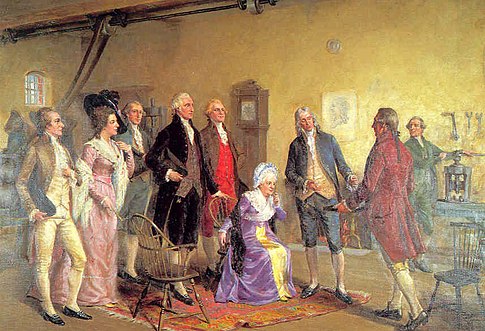
- In Germany, he was employed in his youth at the Royal Mint of Saxony at Saxe Gotha
- Emigrated to the US in 1760 and began Pennsylvania employment for clock and instrument maker David Rittenhouse
- In 1770 and 1771 he assisted David Rittenhouse in the construction of an orrery that Rittenhouse sold to the College of New Jersey now known as Princeton University.
- In 1780, he built a mill to manufacture wire in Reading, PA
- He moved to Philadelphia and established a successful watch and clock building and repair business at Second Street between Vine and Race Streets in early Philadelphia
- In 1787 at the time of Thomas's birth, he built the steam engine that powered the first successful steamboat invented by John Fitch, and supported its commercial operation through 1791
- On April 13, 1792 he applied to George Washington for the position of Chief Coiner of the first US Mint at Philadelphia. His application was supported with letters of recommendation from Philadelphians, Jonathan Nancarrow, Timothy Matlack, Henry Deberger Sr., and David Rittenhouse. David Rittenhouse's letter introduced the alternate spelling of his name (“Voight”). On July 9, 1792, President Washington approved his application in writing to US Mint Director, David Rittenhouse. He served in this capacity for the rest of his life.
- In 1793, he discovered a process of making steel from bar iron. He communicated his findings to as many blacksmiths as possible with a published notice in the National Gazette on June 25, 1798.
- In 1803, at the request of architect engineer Benjamin Henry Latrobe, he used documents supplied by Latrobe to copy a surveying instrument for Mississippi Territory Surveyor General Issac Briggs. The instrument was used in the survey of a portion of the Louisiana Purchase, and was later donated to the Smithsonian Institution where today's visitors can observe it. “Henry Voigt Philadelphia” is inscribed on the instrument.
At an early age, Henry and Margaret Voigt's son, Thomas, began an apprenticeship with his father in the watch and clock building portion of his father's diversified business interests. Thomas developed an enthusiastic interest in his father's watch and clock making as a young man, and gradually assumed its lead as his father would feel the demands of his new job as a coiner of the first U. S. Mint.
In 1804 to 1809 Thomas assisted his father on a contract received from the trustees of Princeton University to repair war damage to the orrery built by David Rittenhouse and his father in 1771. Thomas and Henry Voigt brought the orrery to their shop in Philadelphia to complete the repairs.
They moved their business from Second Street between Vine and Race Streets to a location across the street from the first U. S. Mint at Philadelphia – 44 North Seventh Street. Thomas married Maria Kessler who was a granddaughter of German emigrants Mary Ritchouer and Leonard Kessler; daughter of Michael Kessler; and niece of Naval Historian John Kessler.[4][5][6]
Astronomical Case Clock[]
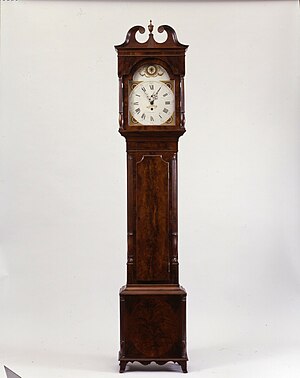

In 1778 Thomas Jefferson began his quest for an accurate timepiece that he could use in astronomical observations.[7] His quest would be delayed by the Revolutionary War, and the early organization of the United States that would include his eight years as Secretary of State; his four years as Vice President; and his eight years as President of the United States. His discussions would first engage Philadelphia scientist and inventor, David Rittenhouse, and later Philadelphia mathematician and second Director of the US Mint at Philadelphia, Robert Patterson. Robert Patterson recommended that President Jefferson engage Philadelphia clockmaker Thomas Voigt. The name was familiar to Jefferson who, years earlier, had engaged Thomas's father, Henry Voigt, to build and repair his clocks and watches.
Jefferson engaged Thomas Voigt to build a tall case clock with advanced time keeping precision that would support his study of lunar and solar cycles. The clock that Voigt would construct for President Jefferson would become known as his Astronomical Case Clock. Thomas completed President Jefferson's Astronomical Case Clock in 1812, but due to the War of 1812, was unable to deliver the finished Clock to President Jefferson's home, Monticello, until December 1815.
The clock that Voigt constructed exceeded Jefferson's desire for simplicity and low cost. Its case was a multi layered polished mahogany structure; its dial decorated with gilt and black lunettes; and its cost ($115.50) was nearly twice the original estimate. Although it was more ornate and more expensive than President Jefferson's original plan, he accepted Thomas's clock and placed the eight-day clock in his private suite of rooms. He used it in his studies until his death on July 4, 1826 – fifty years to the day after the signing of the Declaration of Independence. (www.monticello.0rg/site/house-and-gardens/astronomical-case-clock)
The Astronomical Case Clock measures 94 inches tall, 18 inches wide, and 11 inches deep. The clock was designed for astronomical purposes without a striking mechanism. Its single pendulum and single weight construction operates for eight days without attendance. Jefferson's use of the clock for astronomical studies can be seen from his annotations of the daily weight positions inside the clock.
After President Jefferson's death, his daughter, Martha Jefferson Randolph, needed to sell some of her father's assets to pay his debts. Robley Dunglison, professor of medicine at the University of Virginia, had attended Thomas Jefferson in the period preceding his death, and was presented the Astronomical Case Clock for his medical devotion to President Jefferson in the final period of his life. A small brass plate affixed to the top right rear of the clock's interior reads as follows: “Clock of President Jefferson Gift of daughter Mrs. Randolph to Dr. Rolley Dunglison 1826 ”
The Astronomical Case Clock remained in Dunglison's family until his son, William Ladam Dunglison, donated it to the Historical Society of Pennsylvania in 1894. In 1999, the Thomas Jefferson Foundation with the aid of a private donor, purchased The Astronomical Case Clock from the Historical Society of Pennsylvania for an undisclosed sum and returned it to President Jefferson's study at Monticello where it stands today.
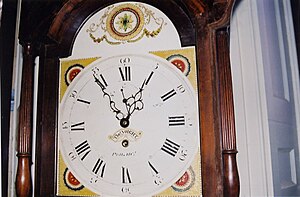
From 1826 to 1999, the Astronomical Case Clock was preserved through the efforts of Dunglison, Dunglison's family, the Pennsylvania Historical Society, a private donor, and the Thomas Jefferson Foundation to stand today in President Jefferson's Monticello study for hundreds of visitors to see, as a symbol of our third president's advanced intellectual curiosity.
Ohio Clock[]
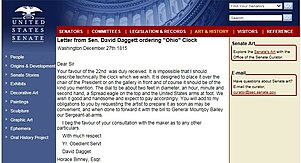

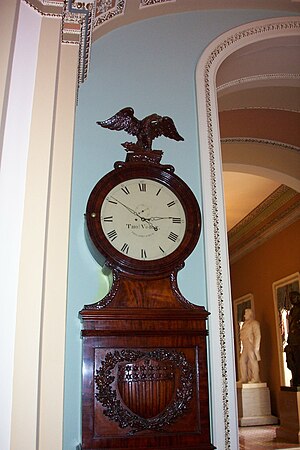

In 1815, the U. S. Senate placed the following order with Thomas Voigt for a clock for its chambers.
In 1816, Voigt delivered the Ohio Clock to the U. S. Senate. In 1816 the U. S. Senate was operating in temporary quarters while the U. S. Capitol was being rebuilt from damage incurred during the War of 1812. In 1819, the U. S. Capitol was restored so that Senate operations could be resumed at the US Capitol. The Ohio Clock was positioned within the restored U. S. Capitol in the Senate Chamber. In 1859, when a new Senate chamber was constructed, the Ohio Clock was positioned opposite the main entrance to the new Senate chamber where it resides today.[8]
The name of the clock that Thomas Voigt delivered to the US Senate in response to Senator Daggett's order has been a topic of speculation. Ohio was the seventeenth state admitted to the union in 1804, but before the clock was delivered to the US Senate, Louisiana, and Indiana were admitted to the union as the eighteenth and nineteenth states in 1812 and 1816 respectively. Its name, The Ohio Clock, has been associated with the seventeen stars and stripes added to the cabinet case by its creator. Thomas Jefferson is widely acclaimed for a major expansion of the United States – the Louisiana Purchase. But, a review of the admission dates of states show that Ohio was the only state admitted to the union during the administration of President Thomas Jefferson – a long time friend and customer of Thomas Voigt and his father, Henry. It may therefore be speculated that Thomas Voigt's use of seventeen stars and stripes represented the admission of Ohio to the union during the presidential administration of Thomas Jefferson.
Legacy[]
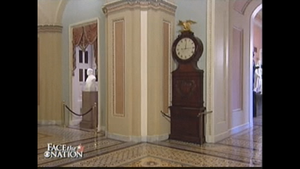
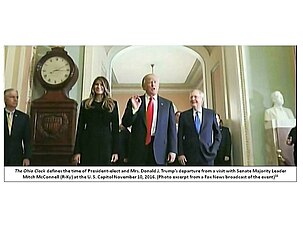
The Astronomical Case Clock survived being transported from Jefferson's Charlottesville Virginia home, Monticello, to Dunglison's home to the Pennsylvania Historical Society and, finally, its return to Monticello. Its survival as an icon of American history and a major furnishing of President Jefferson's private study was enabled by the knowledge and devotion to authenticity of the Thomas Jefferson Foundation. They shared their knowledge of the Astronomical Case Clock with this article's authors after a visit to Monticello in 2004.
From 1819 to the present day, The Ohio Clock has survived U. S. Senate filibusters; impassioned debates; a physical attack on US Senator Charles Sumner (R-MA) in the Senate chamber on May 22, 1856; the US Civil War; two World Wars; and a bomb explosion in 1983. The Ohio Clock’s glass was broken by the 1983 bomb blast, but was quickly repaired and restored to service. Hundred of Senate visitors observe The Ohio Clock each day including Senators, and Senate employees such as former Senate Page David Watson.
During the shutdown of the U. S. Government in 2013, the U. S. Senate employees tasked with maintaining and winding The Ohio Clock were furloughed. The Ohio Clock stopped keeping time during this period. Its stopped status was recorded on national television programs such as Face The Nation,[9] CBS Evening News, and NBC Nightly News to showcase the 2013 government shutdown. When U. S. Senate employees returned to service, the Ohio Clock was reset and its timekeeping operation resumed.[9]
A few days after the November, 2016 election, U. S. Senate Majority Leader, Mitch McConnell invited President–elect Donald Trump to the U. S. Senate for a luncheon meeting. The news media captured Donald and Melania Trump with McConnell near the Senate chambers with The Ohio Clock.[10]
Although turbulence and violence have occurred near The Ohio Clock, it has stood for over 200 years as it stands today - an important symbol of our country's stability, and the longevity of one of its major democratic institutions – the U. S. Senate.
Today, Thomas Voigt and his wife Maria Kessler Voigt reside in a plot near his parents and other family members in Laurel Hill Cemetery in Philadelphia, PA. In addition to his two most famous clocks, Voigt built many other clocks for customers and family members. At least one of these has survived to this day and resides with a descendant family member.
References[]
This article was initiated by the recollections of Thomas Voigt by his descendants Cynthia Cooper, Hubert Joseph Kessler, and Eleanor Ruth Kessler Whitehead. The authors are also grateful to historian Tim McGrath for supplying the autobiography of John Kessler.[4][5][6] This article was prepared by William B. Kessler Jr., Mary K. Kessler, and William B. Kessler III.
Footnotes[]
- ^ a b History Corner: Henry Voigt Professional Surveyor Archives by Silvio A. Bedini Historian Emeritus with the Smithsonian Institution, Washington, DC (Download Here)
- ^ a b 1. Transit and Equal Altitude Instrument Smithsonian National Museum of American History Behring Center Physical Sciences Collection – Surveying and Geodesy Catalogue number: PH*311772
- ^ a b Painting is on display at today’s Philadelphia Mint, 151 Independence Mall East, Philadelphia, PA 19106
- ^ a b Life of John Kessler an 1823 autobiography by John Kessler on file at the Pennsylvania State Archives, 350 North Street, Harrisburg, PA 17120-0090
- ^ a b 1951-, McGrath, Tim (2010). John Barry : an American hero in the Age of Sail. Yardley, Pa.: Westholme. ISBN 9781594161049. OCLC 495778699.CS1 maint: numeric names: authors list (link)
- ^ a b 1951-, McGrath, Tim (2014). Give me a fast ship : the Continental Navy and America's Revolution at sea. New York, New York. ISBN 9780451416100. OCLC 861673685.CS1 maint: numeric names: authors list (link)
- ^ Astronomical Case Clock information furnished by the Thomas Jefferson Foundation and the Thomas Jefferson Encyclopedia
- ^ Photos and information obtained in an October, 2004 visit to the U. S. Capitol by the author obtained with the assistance of U. S. Senate Historian, Richard Allan Baker
- ^ a b Excerpt from the October 13, 2013 television broadcast of Face The Nation on the Columbia Broadcasting System (CBS)
- ^ Excerpt from a November 10, 2016 Fox News telecast of U. S. Senate Majority Leader Mitch McConnell’s introductory meeting with President-elect and Mrs. Donald J. Trump at the U. S. Capitol, Washington, DC
- People from Philadelphia
- 1844 deaths
- American clockmakers
- American people of German descent
- 1787 births